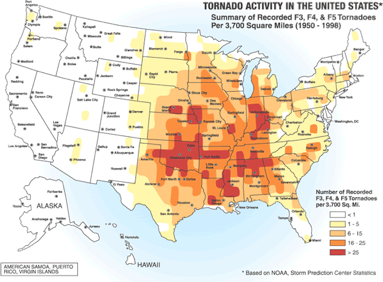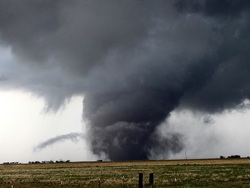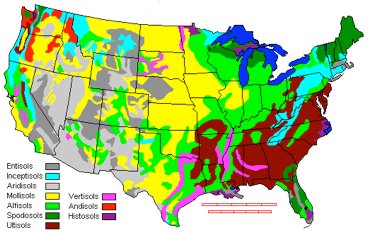
What is Tornado Alley anyway?
EF 0 = 65 - 85 mph
EF 1 = 86-110 mph
EF 2 = 111-135 mph
EF 3 = 136-165 mph
EF 4 = 166-200 mph
EF 5 = > 200 mph

Tornado alley is a weather region term used by the public and news teams to describe an area of the United States where frequent, violent twister patterns, or tornadoes, develop and run along the ground until they die out of energy, Some last only a few minutes, others continue for nearly an hour. The term originated in 1952, following U.S. Air Force scientists, Fawbush & Miller, who actually made the first tornado forecast in 1948.
The following links, in conjunction with the local news-based weather stations, can provide very precise and immediate tornado warnings based on Doppler radar and other satellite data, with options for escaping, sheltering in place, or later mitigation. Take their advice and save your life!
www.weather.gov (enter location in region tab and click GO)
www.weather.com/storms/tornado-central
Your local news stations also
provide timely warnings:
NBC; CBS; ABC.
It is in the midwest region, where hot air-cold air fronts mix to generate a violent atmospheric funnel configuration; this is often potentiated by existing differential convection layers. This phenomena appears to be the primary and fundamental components to generate an active twister. Yet, tornadoes do not just appear everywhere, so the terrain must be unique and also contribute an additional factor.
Besides the midwest of the United States, Florida, England, India, New Zealand, and parts of Asia (and other places, as well) also get tornadoes. There must be something common to the soil and/or lithosphere in these areas, which acts as a conduit for twisters. Soil and ground compositions must also provide some strata where these weather patterns can glide to cause miles of destruction in only a brief period of time.
Tornadoes are currently rated by velocity, on the Enhanced Fujita scale of 0 - 5, where 0 is the weakest and 5 is the most powerful. This scale calibrates the damage-area, which is correlates to windspeed. The old Fujita scale rated tornadoes by the damage and it took a professional to evaluate the strength.
Tornado Alley Forecast site has formulated a new, more accurate and easier way to quantify and classify tornadoes or twisters. It will allow the non professional, amateur, and novice to relate a quick and accurate measure of the tornado, which he or she has just witnessed, to the media, law enforcement, emergency rescue workers, or television stations. The method is based on simple physics and is described in detail on the Mary Ann Slaby Tornado Magnitude Scale page (next page on this website). Basically the magnitude scale is a 0-5 value as it has been in the past; however the numerical value is more related to the energy imparted to the objects from windspeed during the time it is in the ground; remember the windspeed from a hurricane is determined by the windspeed of the water in the air, not the air alone! Similar to the 1934 Richter Scale used to measure earthquakes, proposed by Charles F. Richter, the determined twister or tornado magnitude value is logarithmic.
The Tornado Magnitude and Tornado Wind Speed Theory is derived as follows:

Areas of Florida, England, India, and New Zealand, in general, seem to have minerals, mud and schist rock with the chemical composition of quartz (SiO2); often these deposits contain iron, magnesium mixed with heavier precious elements, in which gold is often found in alluvial form. This presence of Cu and/or Fe is consistent with the “green hue” which is observed in the sky just as an active tornado is developing. Clays (Al2Si2O5OH4, K2O, CaO & kaolin) also are also common in the tornado alley region and make building foundations very difficult to firmly set, especially in Oklahoma.
Enhanced Fujita scale
Original Fujita scale
EF 0 = <73 mph
EF 1 = 73-112 mph
EF 2 = 121-157 mph
EF 3 = 158-206 mph
EF 4 = 207-260 mph
EF 5 = 262-318 mph
In fact, both scales are only approximations of windspeed. The wind speeds are approximate guesses and have never been scientifically measured (see www.spc.noaa.gov). Each is based on the amount of damaged observed, from “light damage” to “incredible damage,” and as evaluated by a professional.
FORMULATION OF A NEW AND MORE ACCURATE TORNADO SCALE
Using Newton’s Law: F = ma; and, a = (v-u)/t
So, F = m(v-u)/t = (mv – mu)/t = p/t
And, Ft = p = Impulse = (J) = mv – mu
And, J = F(t2 – t1) = p
Also, W = F x d = m x g x h = Potential Energy
Therefore, if the object is at rest, then u = 0, so:
Velocity (v) = Work/Force = mass x gravity x height x t/[mass (u – v)]
= (weight x height x time)/[m(v –u)]
And since weight = mg, and initial velocity is = 0, then:
The formula for wind speed is: v2 = W x h x t/m = g x h x t; and,
The formula for Tornado Magnitude =
log10 [g x t (tornado time on ground in min)]
The formula for the Tornado energy = m v2.
The formula for Tornado Damage Magnitude =
log10 [Weight/(height x width x length)] x t (tornado time on ground in min)]
At a practical level, the height to which the largest object has been raised, could be multiplied by a factor, 1.5 or so, since the wind picks it up and then drops it; it usually has been raised to a point higher than where it lands after the tornado passes. The data table does not contain a raised correction factor.
Tornado and twister forecasts, for the United States, will use this method at the website: http://www.TwisterForecast.com. However, in order to perform amateur, yet highly accurate, onsite and immediate tornado and twister damage estimates, you will need to consult with a table of the mass for various items that you observe damaged. The Tornado Damage Magnitude is based on the weight of the largest object thrown around in the storm!!! So, you must calculate the relative density of the object by dividing by the estimated or measured length, width, and height. The mass of the largest object ,which you can determine was lifted and displaced, provides a very accurate tornado damage value, which is proportional to the wind speed and the old Enhanced Fujita Tornado Scale. This website is offering a laminated data table of masses which can be carried by police, emergency workers, FEMA, or tornado storm chasers and used to immediately compute the tornado strength. This table costs $350.00 and ships free within the United States. You cannot make accurate tornado damage estimates without it and cell phone service is often not available in an area damaged by a twister for several days. This table provides quick, precise, lookup data to make your calculations on the spot. All you will need is a calculator, a tape measure and a photo or visual image of the largest damaged item to to match in the table to determine the tornado damage magnitude. Please order below if you are interested. The first orders will ship around January 1, 2020.

Table of Tornado Magnitude by Time and Wind Speed by Object Height


